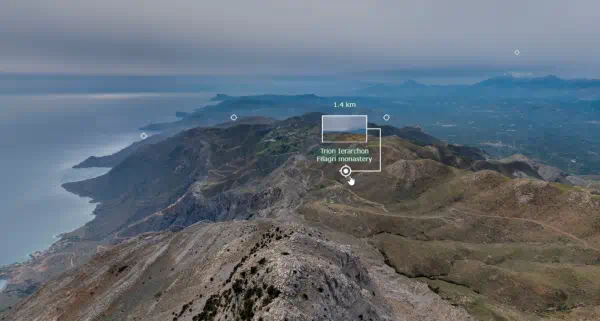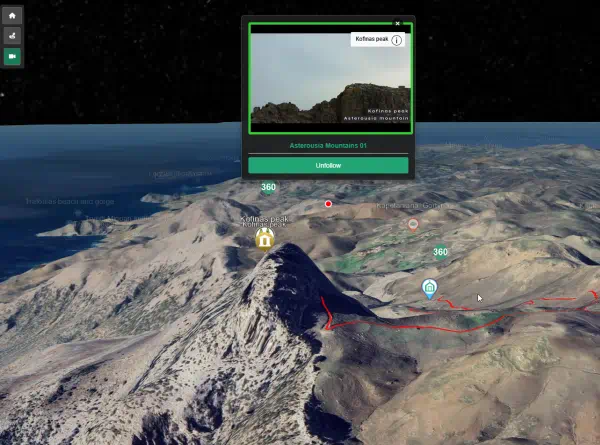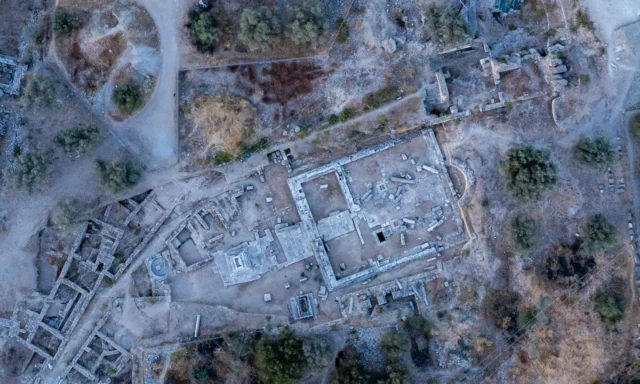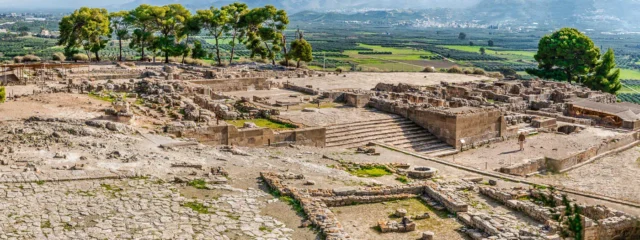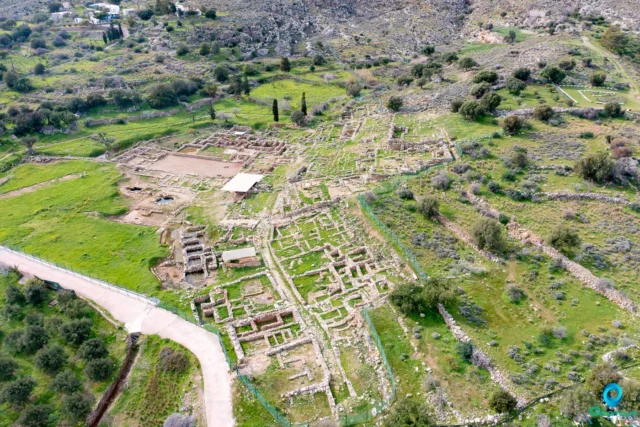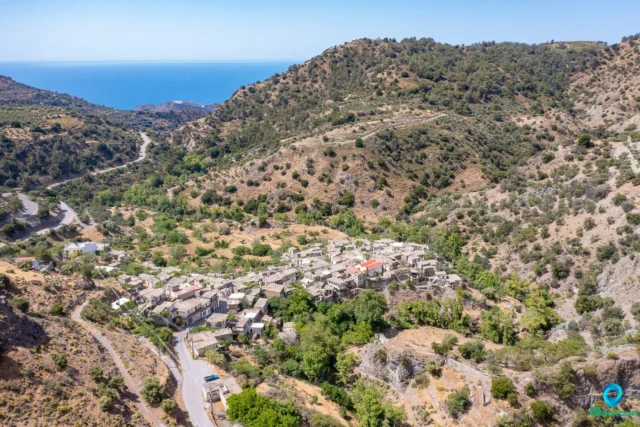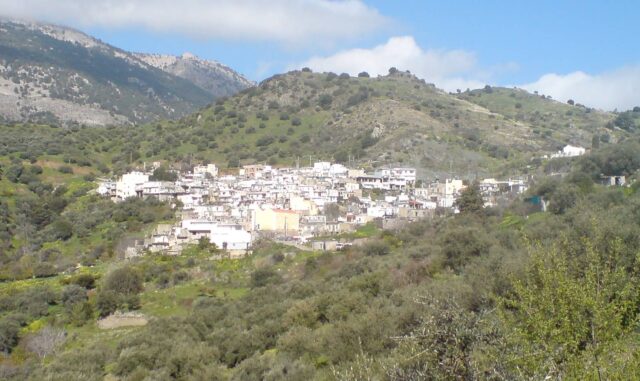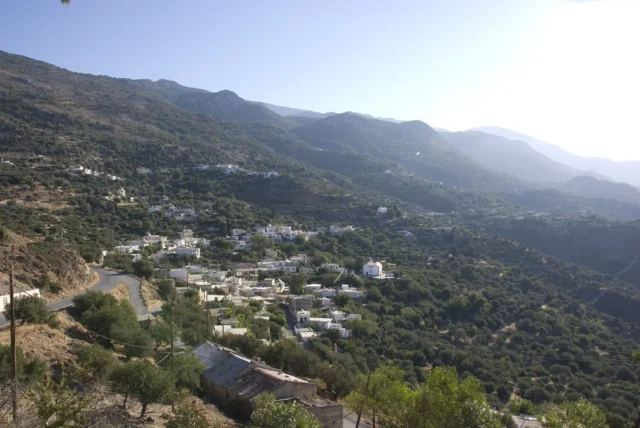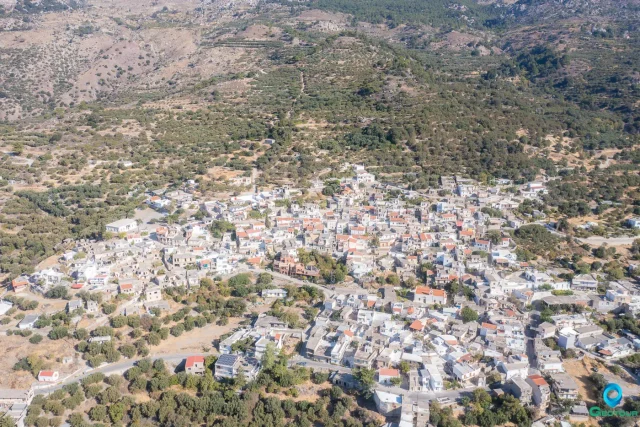The Sanctuary of Hermes and Aphrodite at Syme Viannou, also known as Kato Syme, is an exceptionally long-lived and significant cult site in Crete. It is located on a plateau on the southern slopes of Mount Dikte, at an altitude of 1,130 meters, offering an unimpeded view of the Libyan Sea. The site’s remote location, characterized by densely wooded slopes, caves, and an abundantly flowing spring, was chosen to foster greater contact with the primordial powers of nature and served as a crucial hub along a mountain pass connecting the northwest and southeast of the island.
The sanctuary operated continuously for approximately 27 centuries, from about 2000 BCE until the 7th century CE, demonstrating its unparalleled prominence and the enduring importance of its rituals. This long use provides a unique opportunity to study the development of religious concepts and cult rituals over millennia, although successive building programs and natural calamities have resulted in heavily disturbed stratigraphic deposits.
Periods of Activity and Architectural Development:
• Minoan Period (Protopalatial to Neopalatial): The sanctuary was founded in Middle Minoan (MM) times, experiencing its first period of prominence during the Protopalatial period with the construction of monumental cult buildings. During the Neopalatial period, the sacred space underwent a radical transformation, featuring monumental open-air arrangements, including a large stone-built podium within an immense sacred enclosure, encircled by a winding, paved sacred road. This era saw significant palatial involvement in the sanctuary’s development.
• Postpalatial, Subminoan (SM) and Early Geometric (LM IIIC-SM) Periods: During the Postpalatial period, small-scale additions and repairs were made to existing structures, though these were later destroyed. In the LM IIIC, a new building (Building L) was founded, followed by the construction of an altar. This period is marked by the increasing use of “unambiguous votives” and is believed to be when initiation rites for young aristocratic males began. The site was one of the more important extra-urban sanctuaries of its time, showing signs of religious syncretism.
• Geometric (G) and Early Archaic (EA) / Protogeometric (PG) to Orientalizing (O) Periods: This was a particularly important phase in the sanctuary’s history. A new altar became the focus of the site, around which three extensive, stepped terraces were constructed in the Late Geometric/Early Archaic periods. The G-O period was one of the three most prosperous in the sanctuary’s long history.
• Hellenistic (HL) and Roman Periods: A small temple (Building C-D) was erected in the Hellenistic period and remained in use until the Roman period. Later, an oikos-temple was built near the perpetually flowing spring. The site’s continuous use extended into the Early Christian period before its eventual abandonment.
• Modern Rediscovery: The sanctuary was rediscovered by chance in 1972 during road construction and was subsequently excavated from 1972 to 2003 under the direction of Angeliki Lebessi.
Cult Practices and Deities: The sanctuary’s activities largely involved open-air rituals, including the lighting of bonfires, animal sacrifices, libations, and ritual feasting. These activities left deep traces in thick, black, greasy layers containing abundant remains of animal bones and offerings.
• Deities: From the early 1st millennium BCE, the principal deities worshipped were Hermes and Aphrodite. The vegetation aspect of Hermes is thought to have Minoan roots, with the association between the two deities potentially reflecting a sacred marriage between a Minoan goddess and a young god of vegetation. Later, Hermes was also known by the epithet ‘Kedritas’ (of the cedar tree). Hermes’ roles included protection of flocks, travelers, and boundaries, and he was linked to human fertility and sexual prowess, often depicted ithyphallically. Aphrodite’s cult at Syme emphasized female sexuality.
• Rites of Passage: A crucial aspect of the cult, particularly from the early 1st millennium BCE, was the celebration of coming-of-age (initiation) rites for young aristocratic males and females from various cities in Eastern and Central Crete. This involved placing themselves under the protection of Hermes and Aphrodite. Hunting, especially of agrimia (wild goats), became a prominent theme in the 7th century BCE, reflecting an aristocratic interpretation of Hermes’ rural aspects and connecting to male maturation rites.
• Sacrificial Practices: While extensive animal slaughter and consumption occurred, burnt animal sacrifice is not attested in the same way as in contemporary hearth temples. Instead, practices included libations using chalices similar to Minoan precursors and the offering of whole animal heads, linking to older Minoan traditions like the bucranium.
Notable Findings: Thousands of offerings in clay, stone, and metal, spanning from the Minoan to the Roman period, have been discovered:
• Pottery:
◦ Pre-firing marks on vessels and fragments, with 98 examples belonging to 24 basic type groups. A large group of these marks from Syme dates to MM IB, with others from MM IIB to LM IA.
◦ A rim sherd from a conical pithos (SM 97) with a Linear A script AB27 was found, dated MM IIIA-LM IB.
◦ Conical cups and chalices were abundant, indicating banqueting and libations.
◦ One marked tumbler (SM 72) was identified as a Pediada import.
◦ Pithoi for long and short-term storage, typically holding 90-100 liters.
• Figurines:
◦ A multitude of bronze and clay human and animal figurines, including adorants.
◦ In the LM IIIC-SM period, terracotta animal figures, especially bovids, and fantastical figures were common.
◦ During the PG-O periods, bronze animal figurines (sheep, goat, cattle, horses, lions, dogs) and ithyphallic male figurines were prevalent.
• Metal Objects:
◦ Over 60 figurative bronze cut-out plaques, primarily depicting male worshippers, from the early 7th century BCE, are distinctive to Syme. These plaques provide insights into Hermes’ iconography, blending Minoan heritage with Greek representations.
◦ Swords, bronze votive Double Axes (possibly LM IIIC-SM), tripod-cauldrons, small ‘discs’, arrowheads, and lance heads.
◦ Precious jewelry.
• Stone Objects:
◦ Offering tables, some inscribed with Linear A. Stone ritual and libation vessels were found, with Minoan stone offering tables depicted on 7th-century bronze plaques and reused in later periods.
Significance: Syme Viannou stands out as an interregional sanctuary that attracted elite worshippers from different communities across central and east-central Crete. Its location at a junction of regional boundaries fostered its use as an aristocratic meeting place and arena for ritualized competition. The sanctuary’s long and rich cult history, combined with the continued visibility of monumental Bronze Age structures like the Sacred Enclosure, contributed to its enduring attraction and allowed later elites to affiliate themselves with a mythical past, fostering an “Eteocretan” consciousness in the east of the island.

